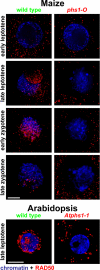PHS1 regulates meiotic recombination and homologous chromosome pairing by controlling the transport of RAD50 to the nucleus
- PMID: 19918061
- PMCID: PMC2785302
- DOI: 10.1073/pnas.0906273106
PHS1 regulates meiotic recombination and homologous chromosome pairing by controlling the transport of RAD50 to the nucleus
Abstract
Recombination and pairing of homologous chromosomes are critical for bivalent formation in meiotic prophase. In many organisms, including yeast, mammals, and plants, pairing and recombination are intimately interconnected. The POOR HOMOLOGOUS SYNAPSIS1 (PHS1) gene acts in coordination of chromosome pairing and early recombination steps in plants, ensuring pairing fidelity and proper repair of meiotic DNA double-strand-breaks. In phs1 mutants, chromosomes exhibit early recombination defects and frequently associate with non-homologous partners, instead of pairing with their proper homologs. Here, we show that the product of the PHS1 gene is a cytoplasmic protein that functions by controlling transport of RAD50 from cytoplasm to the nucleus. RAD50 is a component of the MRN protein complex that processes meiotic double-strand-breaks to produce single-stranded DNA ends, which act in the homology search and recombination. We demonstrate that PHS1 plays the same role in homologous pairing in both Arabidopsis and maize, whose genomes differ dramatically in size and repetitive element content. This suggests that PHS1 affects pairing of the gene-rich fraction of the genome rather than preventing pairing between repetitive DNA elements. We propose that PHS1 is part of a system that regulates the progression of meiotic prophase by controlling entry of meiotic proteins into the nucleus. We also document that in phs1 mutants in Arabidopsis, centromeres interact before pairing commences along chromosome arms. Centromere coupling was previously observed in yeast and polyploid wheat while our data suggest that it may be a more common feature of meiosis.
Conflict of interest statement
The authors declare no conflict of interest.
Figures







Comment in
-
Pairing in plants: Import is important.Proc Natl Acad Sci U S A. 2009 Nov 24;106(47):19751-2. doi: 10.1073/pnas.0911849106. Epub 2009 Nov 18. Proc Natl Acad Sci U S A. 2009. PMID: 19923432 Free PMC article. No abstract available.
References
-
- Pawlowski WP, Cande WZ. Coordinating the events of the meiotic prophase. Trends Cell Biol. 2005;15:674–681. - PubMed
-
- Pawlowski WP, et al. Coordination of meiotic recombination, pairing, and synapsis by PHS1. Science. 2004;303:89–92. - PubMed
-
- Zickler D, Kleckner N. Meiotic chromosomes: Integrating structure and function. Annu Rev Genet. 1999;33:603–754. - PubMed
-
- Waterworth WM, et al. NBS1 is involved in DNA repair and plays a synergistic role with ATM in mediating meiotic homologous recombination in plants. Plant J. 2007;52:41–52. - PubMed
MeSH terms
Substances
LinkOut - more resources
Full Text Sources
Molecular Biology Databases
Research Materials
Miscellaneous

